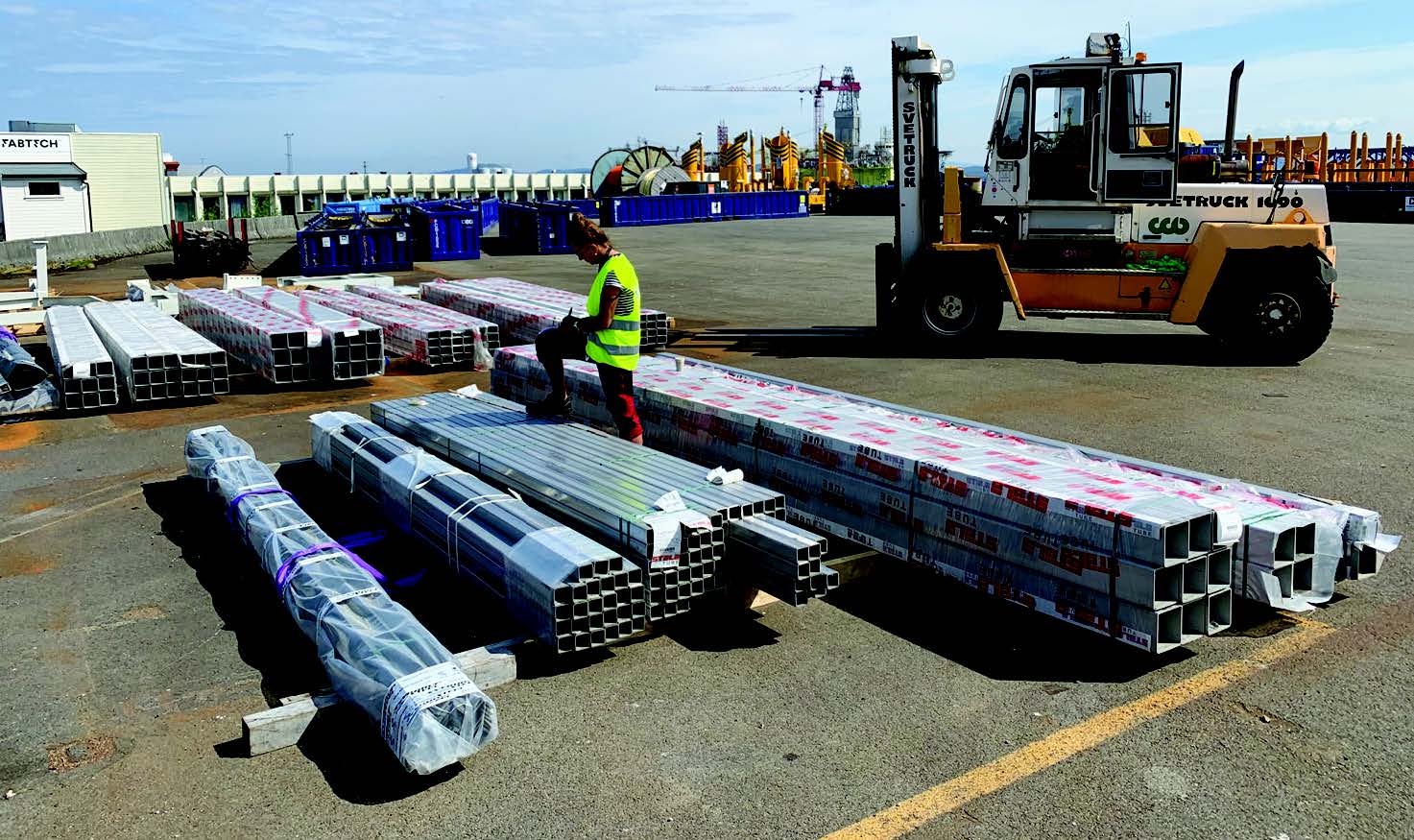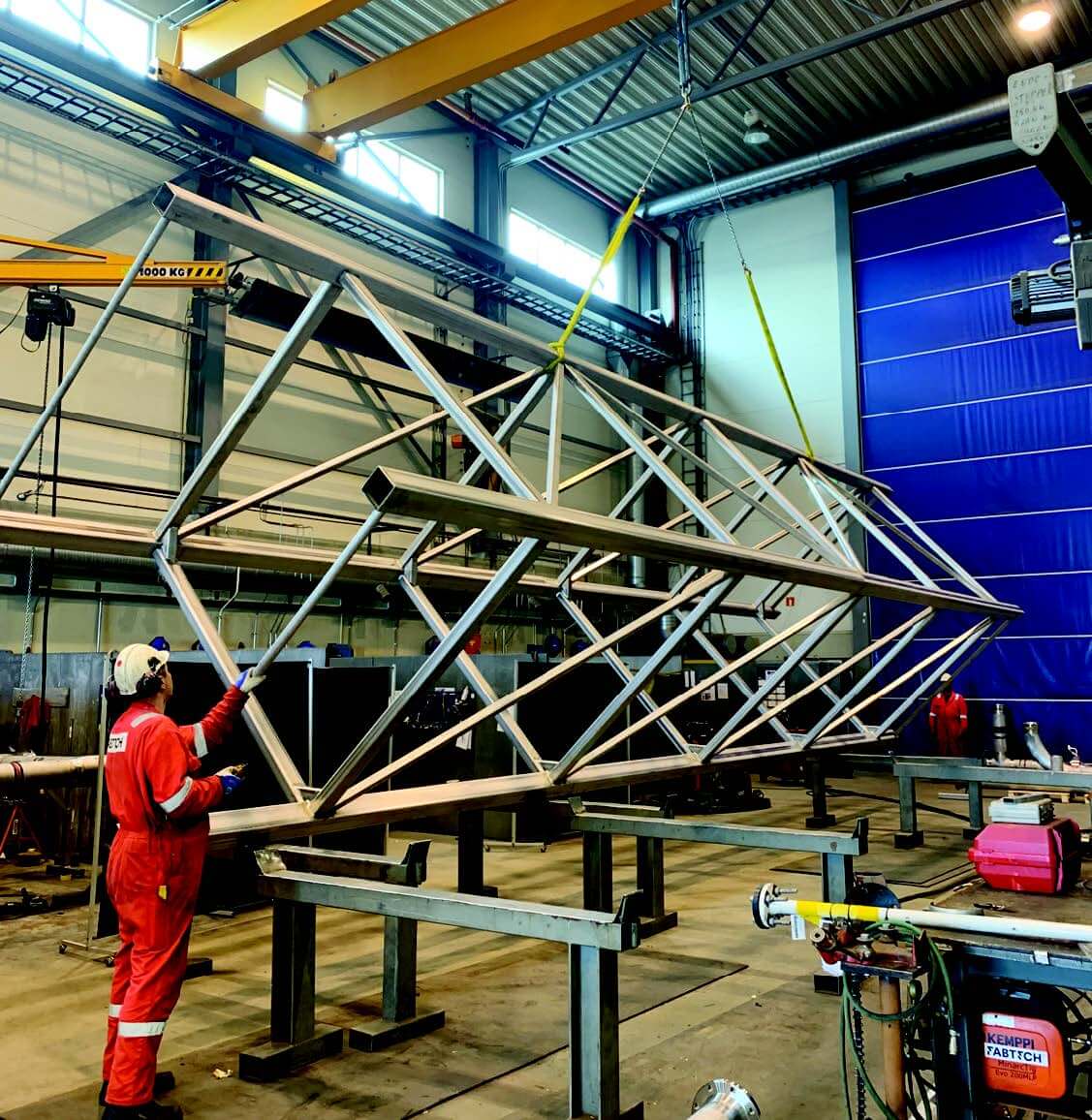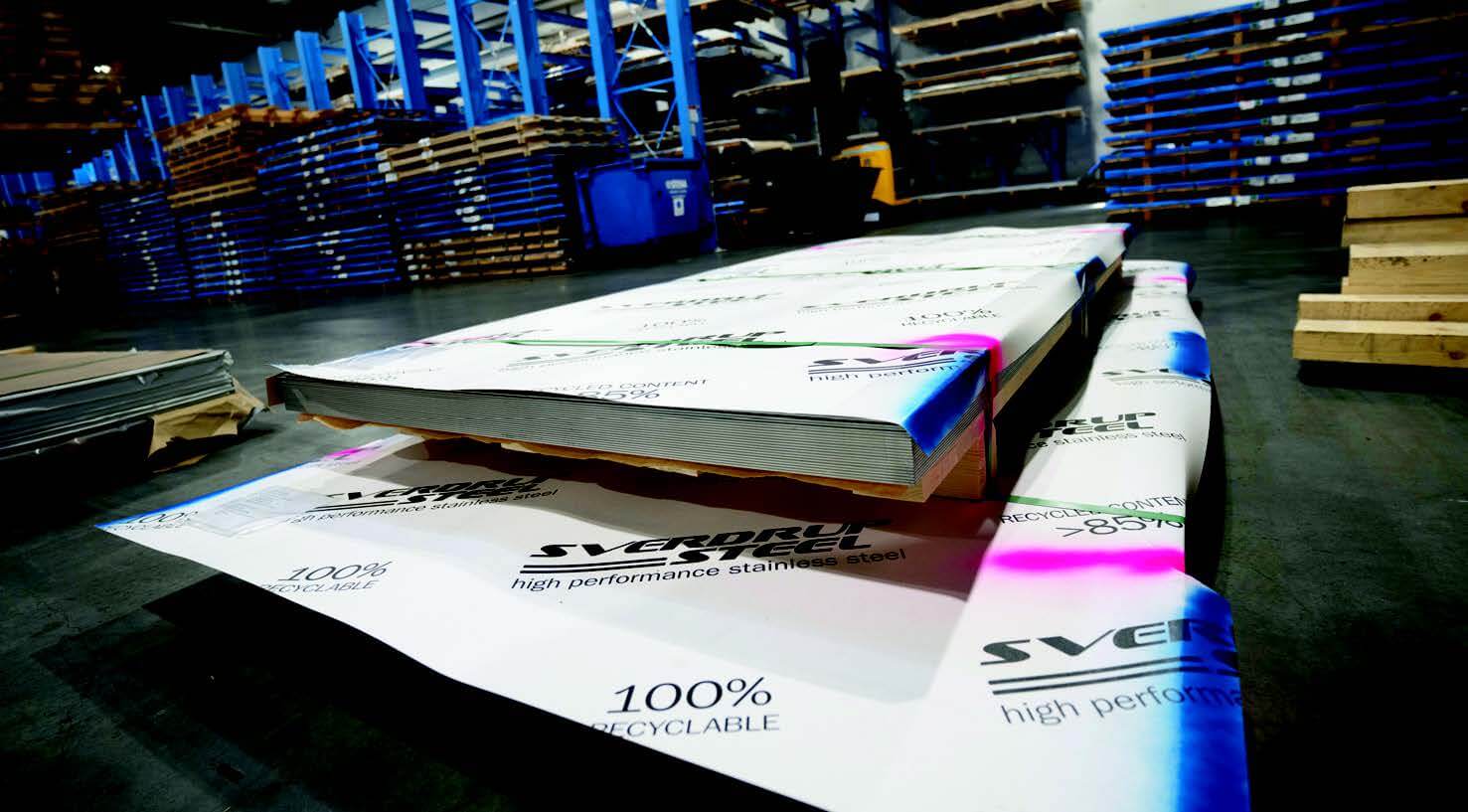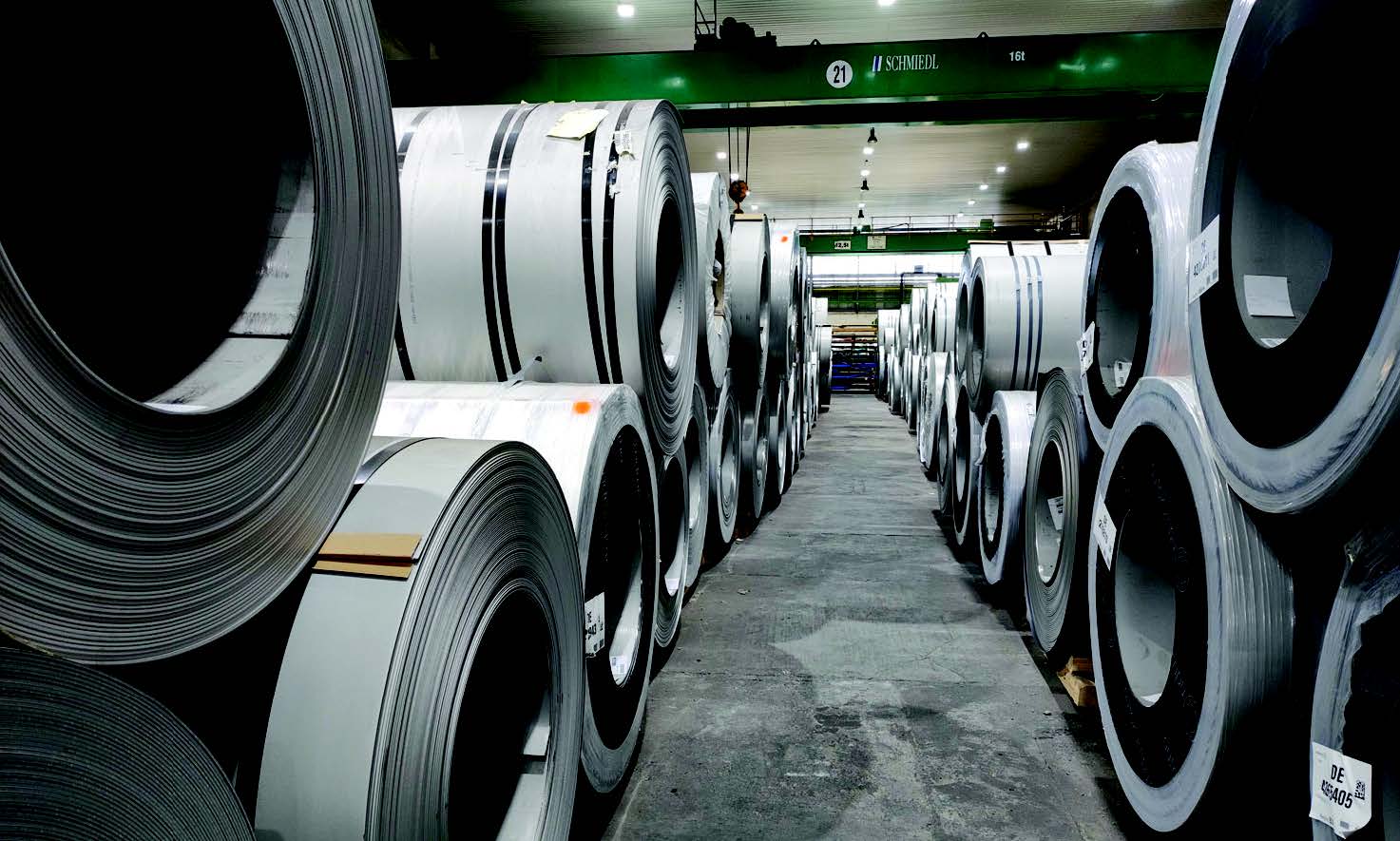Sverdrup Steel has completed together with Fabtech a groundbreaking project highlighting the huge potential for duplex stainless steel to replace carbon steel in offshore structures. Transitioning to duplexes offers significant savings in terms of lifecycle cost, maintenance, overall weight, and a reduced CO2 footprint. As a global supplier of high-end alloys, the company works closely with customers and uses its extensive in-house expertise to promote the use of duplex and other stainless steels in a wide range of applications.
By Joanne McIntyre
In the fall of 2020, Sverdrup Steel’s partner company, Fabtech, was commissioned by Equinor to build two new footbridges to replace existing bridges at the Mongstad oil refinery facility in Norway. Fabtech is a Norwegian fabricator of mechanical constructions for the MMO and Subsea markets with over 40 years of experience.
The initial brief was to build the largescale bridges using the same design as the original structures, in painted carbon steel. However, facing the very high cost of painting and the continuous maintenance operations needed after installation, Fabtech invited Sverdrup Steel to search for alternative solutions.
Recognising a unique opportunity to challenge traditional thinking, the Sverdrup Steel team combined their focus on sustainable solutions with their extensive in-house materials knowledge to develop an alternative plan. The result: a plan to replace the carbon steel bridges with lean duplex structures, offering a sustainable and durable solution.
Reduced lifecycle costs
Sverdrup Steel considers an essential part of its business to assist its partners and clients with more sustainable and cost-efficient solutions by utilising the advantages of high-performance alloys. The use of lean duplex instead of carbon steel enabled the construction of a lighter structure while almost eliminating the need for maintenance, reducing the CO2 footprint of the project, and lowering the overall lifecycle cost.
With expert assistance from the company’s technical team of metallurgists and excellent material availability, the change from carbon steel footbridges to lean duplex was soon a reality appreciated and approved by Equinor. The selected material grade was lean duplex EN 1.4362/UNS S32304 in accordance with NORSOK M:120 – MDS YD37. Sverdrup supplied over 2,000 meters of hollow structural sections, in addition to plates and hot rolled angle bars in lean duplex from its warehouses in Norway.


Wide range of materials available
As with any project, the availability of the grades specified is essential for success and on-time completion. As a leading specialist in this industry with many years of experience, Sverdrup Steels’ technical department of metallurgists has amassed unique know-how and knowledge. Today, two of the most critical services it provides to partners and clients are technical assistance and high stock levels at its warehouses and service centres in Europe and Asia. This is in contrast with other, more traditional suppliers in the industry whose focus is high inventory turnover. The well-maintained high stock level of Sverdrup’s products reassures clients of material availability and security of supply from the company’s warehouses and service centres.
In addition, Sverdrup Steel is constantly developing its range of product forms in cooperation with clients to serve projects in the best possible way. Often, the company is closely involved with projects from a very early phase. This allows the company’s technical experts to assist with material standardisation while at the same time giving the company time to add new thicknesses or shapes to its stock programme as required by the project for the best possible optimisation.
Material experts and metallurgists within the Sverdrup Steel organisation are regularly in contact with engineering companies, architects, etc, to provide support in achieving correct material choices depending on the different challenges which may arise during engineering, and later during the manufacturing phase. This close collaboration is a win/win situation for both parties.
Sustainability in construction The increased focus on sustainability within Sverdrup Steel reflects the increasing importance of this topic across the industry. While sustainability was rarely mentioned in the bridge and general construction industry five years
ago, by 2019, a buzz started to develop around the topic. Today, almost every industry event and conference has a major focus on sustainability and reducing the carbon footprint of projects. That has caused designers and engineers to start re-evaluating the materials they use.
Sustainability in construction
The increased focus on sustainability within Sverdrup Steel reflects the increasing importance of this topic across the industry. While sustainability was rarely mentioned in the bridge and general construction industry five years ago, by 2019, a buzz started to develop around the topic. Today, almost every industry event and conference has a major focus on sustainability and reducing the carbon footprint of projects. That has caused designers and engineers to start re-evaluating the materials they use.
Advantages of lean duplex
– High strength
– Good corrosion resistance
– More predictable and stable price level
– High fatigue strength
– More than 30% weight saving on most applications
– Low life cycle cost as painting is not required
– 100% recyclable and made from more than 85%
recycled material
Duplex stainless steel
Duplex stainless steel offers an interesting alternative to carbon steel for the load-bearing elements in steel bridges. Its high corrosion resistance means that Duplex stainless steel does not require painting. This cuts maintenance costs and eliminates risks to the health and safety of maintenance crews, as well as the associated environmental risks from shot blasting and painting operations.
Bridge projects generally favour duplex stainless steel grades – typically lean duplex LDX 2101, EDX 2304 and also standard 2205 – as they offer the benefits of higher strength, especially compared with S355 carbon steel.
Utilising the strength of duplex compared to carbon steel and ordinary stainless steel, allows lightweight, slender and elegant designs which reduce costs due to weight savings by reducing the thickness. Costs are also lowered as a result of reduced handling, fabrication, welding and logistics as less material is required than with carbon steel structures. Reducing all of these factors also helps cut carbon dioxide emissions.
Furthermore, duplex stainless steel is known for its improved balanced chemistry of chromium, molybdenum, and nitrogen content, allowing less nickel content and therefore better price stability. Today, a vast number of different types of bridges are built in these alloys.


Rising use of lean duplex
Over the past five to ten years, the amount of lean duplex specified in bridge and general construction projects has increased significantly. Sverdup Steel stocks a wide range of grades for this industry including:
- EN 1.4482 – UNS S32001 – LD24 – PRE24
- EN 1.4162 – UNS S32101 – LDX2101 – PRE26
- EN 1.4362 – UNS S32304 – EDX2304 – PRE28 (NORSOK)
The increasing interest in lean duplex is largely the result of new thinking to explore innovative ways to be more cost-efficient, sustainable, and competitive. Today it is clear that lean duplex is becoming the preferred material of choice for applications such as storage tanks, pressure vessels, heat exchangers, bridges, railings, feeding systems, water treatment systems, pipe support and fire- and blast walls on offshore platforms.
As a solution provider, Sverdrup Steel has worked closely with its customers for many years to specify and utilise the benefits of lean duplex. Its team has learned that it needs to offer a wide range of product forms and have excellent stock availability. Today, its standardised stock program includes hot rolled angles and hollow structural sections in lean duplex, as well as plates. It can also offer flat bars, press-brake, and welded profiles with short delivery times.
The company expects interest in the use of lean duplexes will only continue to increase in the years ahead, with a higher focus on more sustainable and durable solutions.
Lean duplex 1.4362/UNS S32304/EDX 2304
Lean duplex EDX 2304 according to NORSOK M-120 MDS YD35 has improved balanced chemistry of chromium, molybdenum and nitrogen content, resulting in a PRE value ≥ 28 and increased mechanical strength compared to the standard UNS 32304. Lean duplex EDX 2304 outperforms both 1.4404 and 1.4436 with respect to pitting corrosion resistance. Due to the risk of embrittlement, duplex steels should not be used in general at temperatures above 250 – 325°C.
The main applications for 1.4362/lean duplex UNS S32304/EDX 2304 are for details with special requirements for high corrosion resistance.
UNS S32304 is characterised by:
• Good resistance to stress corrosion cracking
• Good resistance to pitting and crevice corrosion
• High resistance to general corrosion
• High mechanical strength
• High resistance to erosion corrosion and corrosion fatigue
Updated standards
Updates of standards in the bridge and construction industries have encouraged the use of lean duplexes. In recent years, there has been an increased focus on expanding established standards to include lean duplexes to utilise this material family’s properties for new applications. The best example is NORSOK M120:2021 material data sheets (MDS) for offshore steel structures, including duplex structural steels, especially lean duplex.
Manufacturers of hollow sections have also been using product standards and requirements to identify the possibilities by utilising the increased strength of duplex compared to austenitic stainless steel and re-design the product without compromising on stiffness.


Promoting duplex for the future
The Sverdrup Steel team have long recognised that by sharing their inhouse expertise and working closely with clients, they can increase the focus on using (duplex) stainless steel as an alternative to carbon steel. However, they also emphasise the importance of manufacturers continuing to educate and promote the material’s benefits. As a leading supplier, they consider it an important part of their job to continue offering good availability and a wide range of product forms. In addition, the company arranges technical seminars and promotes duplexes in close collaboration with its clients. Looking ahead, the company anticipates a bright future for duplex stainless steel in bridges and other marine structures.
Facts & Figures
| Name: | Sverdrup Steel |
| Headquarters: | Stavanger, Norway |
| Market: | Exports to over 70 countries |
| Key industries: | Energy and heavy industries, renewables, aquaculture, marine and shipbuilding, building and construction, pulp and paper, chemical and process industries |
| Products: | Duplex (incl. super & lean), austenitic alloys, martensitic alloys, nickel alloys, titanium, low alloys |
| Certificates: | ISO 9001, ISO 14001, Achilles JQS, Achilles Utilities 2022 |
| Website: | sverdrupsteel.com |
About this Featured Story
This Featured Story appeared in Stainless Steel World November 2022 magazine. To read many more articles like these on an (almost) monthly basis, subscribe to our magazine (available in print and digital format – SUBSCRIPTIONS TO OUR DIGITAL VERSION ARE NOW FREE) .
Want to contribute as author? Please contact Joanne.
Every week we share a new Featured Story with our Stainless Steel community. Join us and let’s share your Featured Story on Stainless Steel World online and in print.


